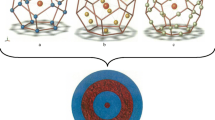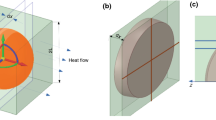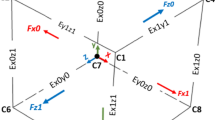Abstract
In this work, the authors introduce an octahedral body centered model transformed into a nine-layer spherical model, to simulate the periodic microstructure of particulate composites. This model takes into account the vicinity of internal and neighboring particles in the form of their deterministic configurations inside the matrix, along with the concept of interphase on the thermomechanical properties of the overall material. The latter is assumed to be homogeneous and isotropic. Next, by the use of this model, in association with classical elasticity approach, a closed form expression to calculate the thermal expansion coefficient of this category of composites is derived The theoretical predictions were compared with experimental results as well as with theoretical values yielded by formulae derived from other workers and they were found to be in good agreement.










Similar content being viewed by others
References
Nielsen LE (1974) Mechanical properties of polymers and composites, vol 2. Marcel Dekker Inc., New York
Kerner EH (1956) The elastic and thermo-elastic properties of composite media. Proc Phys Soc Lond B69(2):808–813
Hashin Z (1962) The elastic moduli of heterogeneous materials. J Appl Mech 29:143–150
Hashin Z, Shtrikman S (1963) A variational approach to the theory of the elastic behavior of multiphase materials. J Mech Phys Solids 11:127–140
Sideridis E, Papanicolaou GC (1988) A theoretical model for the prediction of thermal expansion behaviour of particulate composites. Rheol Acta 27:608–616
Maxwell JC (1873) Electricity and magnetism. Clarendon, Oxford
Benveniste Y (1987) Effective thermal-conductivity of composites with a thermal contact resistance between the constituents–nondilute case. J Appl Phys 61:2840–2843
Nan CW, Birringer R, Clarke DR, Gleiter H (1997) Effective thermal conductivity of particulate composites with interfacial thermal resistance. J Appl Phys 81:6692–6699
Duan HL, Karihaloo BL, Wang J, Yi X (2006) Effective conductivities of heterogeneous media containing multiple inclusions with various spatial distributions. Phys Rev B 73:174203–174215
Pal R (2007) New models for thermal conductivity of particulate composites. J Reinf Plast Compos 26:7643–7651
Balch DK, Fitzgerald TJ, Michaud VJ, Mortensen A, Shen Y-L, Suresh S (1996) Thermal expansion of metals reinforced with ceramic particles and microcellular foams. Metall Mater Trans A 27(11):3700–3717
Roudini G, Tavangar R, Weber L, Mortensen A (2010) Influence of reinforcement contiguity on the thermal expansion of alumina particle reinforced aluminium composites. Int J Mater Res 101:1113–1120
Garboczi EJ, Berryman JG (2000) New effective medium theory for the diffusivity or conductivity of a multi-scale concrete microstructure model. Concr Sci Eng 2:88–96
Lutz MP, Zimmerman RW (2005) Effect of an inhomogeneous interphase zone on the bulk modulus and conductivity of a particulate composite. Int J Solids Struct 42:429–437
Yin HM, Sun LZ (2005) Elastic modelling of periodic composites with particle interactions. Philos Mag Lett 85(4):163–173
Sideridis E, Venetis J (2014) The stiffness and thermal expansion coefficient of iron particulate epoxy composites defined by considering the particle contiguity. Int Rev Model Simul 7:671–681
Sideridis E, Venetis J (2014) Thermal expansion coefficient of particulate composites defined by the particle contiguity. Int J Microstruct Mater Prop 9:292–313
Venetis J, Sideridis E (2016) A mathematical model for thermal conductivity of homogeneous composite materials. Indian J Pure Appl Phys 54(5):313–320
Zhang H, Zhang Z, Friedrich K, Eger C (2006) Property improvements of in situ epoxy nanocomposites with reduced interparticle distance at high nanosilica content. Acta Mater 54:1833–1842
Zhou TH, Ruan WH, Mai YL, Rong MZ, Zhang MQ (2008) Performance of nanosilica/ polypropylene composites through in-situ cross-linking approach. Compos Sci Technol 68:2858–2863
Thorvaldsen T, Johnsen BB, Olsen T, Hansen FK (2015) Investigation of theoretical models for the elastic stiffness of nanoparticle-modified polymer composites. J Nanomater 4:1–17
Mirza FA, Chen DL (2015) A unified model for the prediction of yield strength in particulate-reinforced metal matrix nanocomposites. Materials 8:5138–5153
Ye J, Chu C, Zhai Z, Wang Y, Shi B, Qiu Y (2017) The interphase influences on the particle-reinforced composites with periodic particle configuration. Appl Sci 7(1):102
Arthur G, Coulson JA (1964) Physical properties of uranium dioxide-stainless steel cermets. J Nucl Mater 13:242–253
Thomas JP. Effect of Inorganic Fillers on Coefficient of Thermal Expansion of Polymeric Materials, General Dynamics, Fort Worth, Texas, USA AD 287–826.
Fahmy AA, Ragai AI (1970) Thermal expansion behaviour of two-phase solids. J Appl Phys 41:5108–5111
Wang TT, Kwei TK (1969) Effect of induced thermal stress on the coefficient of thermal expansion and densities of filled polymers. J Polym Sci 7(5):889–896
Malliaris A, Turner DT (1971) Influence of particle size on the electrical resistivity of compacted mixtures of polymeric and metallic powders. J Appl Phys 42:614–618
Tummala RR, Friedberg AL (1970) Thermal expansion of composite materials. Symposium on thermal expansion of solids. J Appl Phys 11(13):5104
Lipatov YS (1977) Physical chemistry of filled polymers. Khimiya, Moscow (Translated from the Russian Moseley RJ International polymer science and technology. Monograph 2; see also Lipatov YS Adv Polym Sci 22:I-59,
Theocaris PS (1987) The mesophase concept in composites, polymers—properties and applications. In: Henrici-Olivé G, Olivé S (eds), vol 11. Springer. ISBN: 978-3-642-70184-9 (Print) 978-3-642-70182-5
Author information
Authors and Affiliations
Corresponding author
Ethics declarations
Conflicts of interest
The authors declare that there is no conflict of interest regarding the publication of this paper
Appendix
Appendix
Let us remark some reliable theoretical formulas referring to thermal expansion coefficient of particulate composites.
-
1.
Blackburn equation
$$\begin{aligned} \gamma _C =\gamma _f +\frac{\frac{3}{2}\left( {1-\nu _f } \right) U_m \left( {\gamma _m -\gamma _f } \right) }{\frac{1}{2}\left( {1+\nu _f } \right) +U_m \left( {1-2\nu _f } \right) +\left( {1-2\nu _m } \right) \frac{E_f }{E_m }U_f } \end{aligned}$$(A1)where \(\gamma \) is the cubic thermal expansion coefficient with \(\gamma \) = 3\(^{\alpha }\)
-
2.
Turner equation
$$\begin{aligned} \gamma _C =\frac{U_m \cdot \gamma _m \cdot k_m +U_f \cdot \gamma _f \cdot k_f }{U_m \cdot k_m +U_f \cdot k_f } \end{aligned}$$(A2)where k denotes the bulk modulus
-
3.
Kerner equation
$$\begin{aligned} \gamma _C =\gamma _f U_f +\gamma _m U_m +\gamma _f U_m \left( {\gamma _m -\gamma _f } \right) q \end{aligned}$$(A3)where \(q=\frac{\frac{1}{k_m }-\frac{1}{k_f }}{\frac{U_f }{k_f }+\frac{U_m }{k_m }+\frac{3}{4G_m }}\) The term containing the parameter q denotes the deviation of the values obtained from this expression when compared with the inverse mixing law.
-
4.
Wang and Kwei equation
$$\begin{aligned} \gamma _m =\gamma _m -U_f \cdot q\cdot \left( {\gamma _m -\gamma _f } \right) \end{aligned}$$(A4)where \(q=\frac{\left( {\frac{3E_f }{E_m }} \right) U_f }{\frac{E_f }{E_m }\left[ {2U_f \left( {1-2\nu _m } \right) +1+\nu _m } \right] +2U_m \left( {1-2\nu _f } \right) }\)
-
5.
Tummala–Friedberg equation
$$\begin{aligned} \gamma _m =\gamma _m -U_f \cdot q\cdot \left( {\gamma _m -\gamma _f } \right) \nonumber \\ q=\frac{\frac{1+\nu _m }{2E_m }}{\frac{1+\nu _m }{2E_m }+\frac{1-2\nu _f }{E_f }} \end{aligned}$$(A5) -
6.
Fahmi–Ragai equation
$$\begin{aligned}&\alpha _C \nonumber \\&\quad =\alpha _m -\frac{3U_f \left( {\alpha _m -\alpha _f } \right) \left( {1-\nu _m } \right) }{2\left( {1-2\nu _f } \right) \left( {1-U_f } \right) \frac{E_m }{E_f }+2U_f \left( {1-2\nu _m } \right) +\left( {1+\nu _m } \right) }\nonumber \\ \end{aligned}$$(A6)
Rights and permissions
About this article
Cite this article
Sideridis, E., Venetis, J. A mathematical model for thermal expansion coefficient of periodic particulate composites. Comp. Part. Mech. 6, 29–44 (2019). https://doi.org/10.1007/s40571-018-0196-5
Received:
Revised:
Accepted:
Published:
Issue Date:
DOI: https://doi.org/10.1007/s40571-018-0196-5




